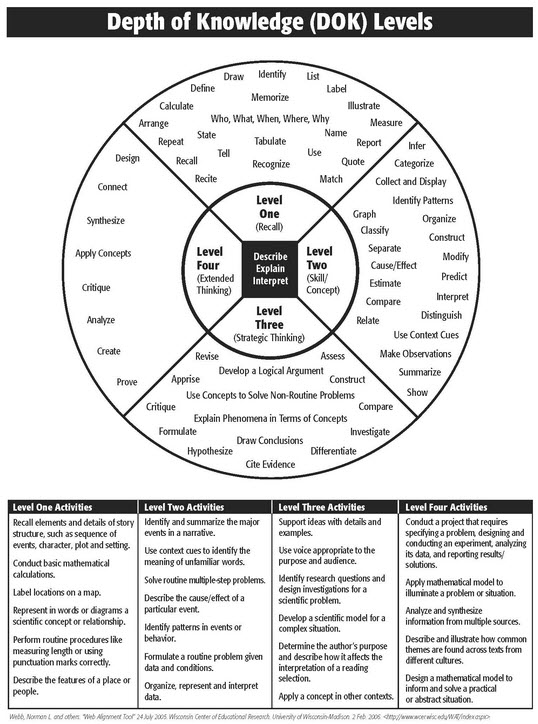9.3 Assessment Item Development
Webb's Depth of Knowledge
Writing items and tasks that fully align to the ideals supporting Next Generation Assessments means that in addition to the requirement of sufficient evidence to verify student achievement, you must also consider the cognitive complexity of each item. Items and tasks within an assessment must reach the full spectrum of cognitive levels, including those of highest complexity. Thus, we must consider both the content that you want the students to demonstrate success with and also the complexity (depth) to which that success should be demonstrated.
View the short video to gain an overview of Webb's Depth of Knowledge (DOK).
The DOK model is an effective component of planning for questioning strategies during the lesson and adding complexity to assessments.
Here is a visual that may be used to associate task verbs to the four levels of DOK. Linked here to view in larger format.

The Smarter Balanced Assessment Consortium has adopted a matrix that highlights both Bloom’s (revised) Taxonomy of Educational Objectives and Webb’s Depth-of-Knowledge Levels. To gain a more in-depth perspective of the use of the martix in writing assessment items you may want to read the article by Hess, Carlock, Jones, & Walkup (2009) available at http://www.nciea.org/publication_PDFs/cognitiverigorpaper_KH12.pdf
In Module 5, you were introduced to the Bloom's Taxonomy verses Webb's Depth of Knowledge, if you would like to review that document, click here.
Digital Portfolio Activity
Now that you have a better understanding of Webb's Depth of Knowledge, it is time to begin working on your assessment item. Open the Item Specification Table in your Digital Portfolio and complete the following:
- Based on the standard(s) you plan to assess, identify the DOK target(s) for your assessment item. (Most assessment items will only have one DOK target.)
After you have identified the DOK target(s) for the standard(s) you are going to assess, click the "Next page" button below.